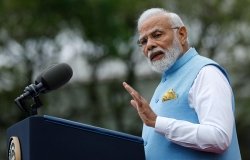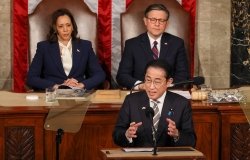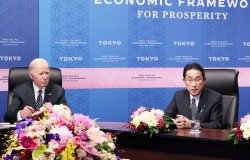
A blog of the Indo-Pacific Program
The Implications of Soleimani’s Killing for South Asia

In the days since an American drone strike killed Qassem Soleimani, the powerful leader of Iran’s Quds Force, much ink has understandably been spilled over the ramifications of the strike for Iran and the broader Middle East.
However, less has been said about the implications for neighboring South Asia—a region that comprises more than a fifth of the world’s population and contributes to more than 15 percent of its economic growth.
U.S.-Iran tensions, and their destabilizing consequences, are of great concern for South Asia—and specifically Afghanistan, India, and Pakistan—for reasons of security, economics, and diplomacy. Indeed, the strike on Soleimani arguably creates more problems for South Asia than any other region outside the Middle East.
Vulnerability to reprisals
Afghanistan is a prime potential target for Iranian reprisals. Twelve thousand U.S. troops are stationed across Iran’s eastern border in Afghanistan—the largest number in any country in Iran’s wider neighborhood other than Kuwait and Qatar. And Iran has proxy partners in Afghanistan capable of carrying out reprisals on U.S. forces.
Between 2013 and 2017, Tehran deployed the Fatemiyoun Division, a militia mainly comprised of Afghan Shias, to Syria to battle the Islamic State terror group and to assist Syrian forces.
Tehran has also provided arms support to the Taliban in recent years, including for an offensive that nearly resulted in the seizure of the capital of the western Afghan province of Farah in 2018.
The Iran-Taliban relationship is complex. Shia Iran and the Sunni Taliban are not natural allies. Iran backed the Northern Alliance, an anti-Taliban movement, in the pre-9/11 years. Taliban forces were implicated in a deadly attack on Iranian diplomats in Afghanistan in 1998.
Still, united in their opposition to Washington, as well as more recently to the Islamic State faction in Afghanistan, Tehran and the Taliban have found common ground.
Still, united in their opposition to Washington, as well as more recently to the Islamic State faction in Afghanistan, Tehran and the Taliban have found common ground. Iran is willing to subordinate sectarian differences to the greater cause of working with partners with similar interests. Witness Tehran’s cooperation with Hamas, another Sunni militant group, which is motivated by a shared objective to undercut Israel.
The resume of Ismail Qaani, Soleimani’s successor and former deputy, also underscores the possibility of Iranian reprisals in Afghanistan. Qaani oversaw Quds Force operations in Afghanistan and neighboring Pakistan, and he had a hand in the formation of the Fatemiyoun Group. In other words, he knows the terrain.
Risks to economic interests
The potential for heightened unrest in the Middle East threatens the economic interests of India and Pakistan, both of which have extensive commercial ties to the region. This is no small matter for New Delhi or Islamabad. They are already suffering from, respectively, the worst economic slowdown in six years and a crippling debt crisis.
India and Pakistan are deeply dependent on energy resources from the Middle East.
India and Pakistan are deeply dependent on energy resources from the Middle East. India’s top four oil suppliers are Iraq, Saudi Arabia, Iran, and the UAE. Pakistan’s top two suppliers are the UAE and Saudi Arabia. A whopping 94 percent of Islamabad’s total crude and oil product imports from the previous fiscal year came from the Persian Gulf. Iranian attacks on ships transiting the Strait of Hormuz—a chokepoint near Iran that conveys 80 percent of Asia-bound oil trade—could deliver a devastating blow to energy security for India. According to International Energy Agency figures, two thirds of India’s oil imports and half of its liquefied natural gas imports pass through this strategic sea lane.
Additionally, Islamabad relies heavily on economic support from the Mideast; Saudi Arabia and the UAE are two of its top donors. Gulf nations are key investment partners for Delhi; the UAE has committed to a $75 billion infrastructure deal. Additionally, New Delhi is developing a port in the southern Iranian city of Chabahar meant to facilitate Indian access to markets in Afghanistan and further afield to Central Asia’s natural gas riches.
Furthermore, the Arab Gulf is home to nearly 9 million Indian and nearly 4 million Pakistani workers, and they are a critical source of remittances. Saudi Arabia and the UAE are Pakistan’s top two sources of remittances. For India, the world’s biggest recipient of remittances, more than half of its global income from remittances comes from the Arab Gulf.
High-stakes diplomatic balancing
India and Pakistan must find ways to balance their respective relationships with Washington and Tehran. New Delhi is intent on strengthening a growing defense partnership with the United States even while continuing to pursue a commercially focused relationship with Iran that is increasingly hamstrung by American sanctions on Tehran.
For Islamabad, the balancing act is more complex. U.S.-Pakistan relations have enjoyed a renaissance amid increased cooperation in Afghanistan. Islamabad is keen to maintain that goodwill in the hope that Washington will end its suspension of Pakistani security assistance and expand bilateral trade and investment. However, Pakistani Prime Minister Imran Khan has sought stronger ties with Tehran as part of an effort to better position Islamabad as a neutral player in the Iran-Saudi Arabia rivalry. Riyadh is one of Islamabad’s closest allies.
Against the backdrop of escalating U.S.-Iran tensions, the stakes are particularly high for Pakistani diplomacy. Pakistan shares a volatile border with Iran that experiences periodic cross-border violence perpetrated by Pakistan-based anti-Iran militants. About 20 percent of Pakistan’s 200-million-strong population is Shia—the largest Shia community outside Iran. And it has security partnerships with Washington and Riyadh, Tehran’s biggest rivals.
Pakistan is at risk of getting dragged into two rapidly intensifying rivalries
Pakistan is at risk of getting dragged into two rapidly intensifying rivalries—Washington and Tehran and Tehran and Saudi Arabia—at a time when it is keen to stay out of both.
Kabul, New Delhi, and Islamabad are all fixated on pressing domestic challenges—insurgency and an election crisis Afghanistan; intensifying anti-government protests in India; and economic distress in India and Pakistan. And yet, Soleimani’s killing and its consequences have major security, economic, and diplomatic implications for these three countries—thereby underscoring the need to allocate more policy space to the dangerous developments unfolding beyond their borders.
Follow Michael Kugelman, deputy director of the Asia Program and senior associate for South Asia, on Twitter @MichaelKugelman.
The views expressed are the author's alone, and do not represent the views of the U.S. Government or the Wilson Center. Copyright 2019, Asia Program. All rights reserved.
About the Author


Indo-Pacific Program
The Indo-Pacific Program promotes policy debate and intellectual discussions on US interests in the Asia-Pacific as well as political, economic, security, and social issues relating to the world’s most populous and economically dynamic region. Read more











